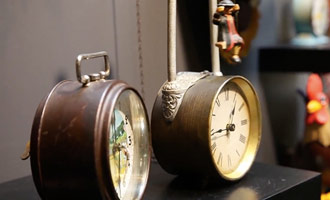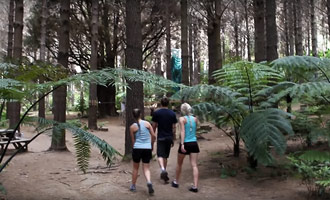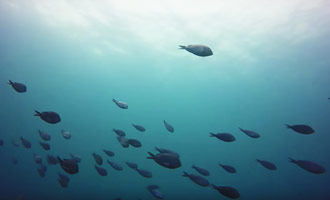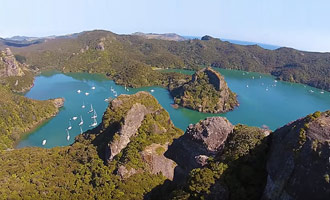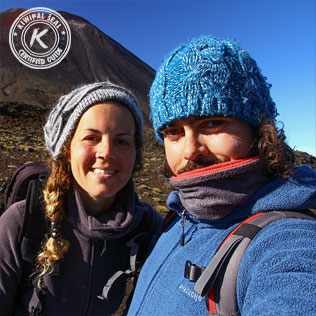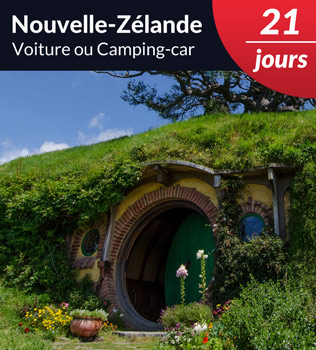
Whangarei and the Treasures of Northland.
Please contact us and we will help you to organize your trip! It's free and without commitment.
- Read the post
- Details
- Advices
Schedule of the Visit.
- 1The North Without Winter.
- 2City Tour and Volcano Climbing.
- 3The Famous Whangarei Falls.
- 4The Charms of the Whangarei Estuary.
- 5Swimming in the Mermaid Pools.
- 6Dive Poor Knight Islands.
- 7Under the Starry Sky of Waipu Caves.
- 8Attending a Kiwi Release.
- 9Whangarei, Jewel of the North Island.
The North Without Winter.

Whangarei in Northland offers breathtaking scenery.
Whangarei is the capital of a region that New Zealanders nicknamed “the North without winter” because of its mild climate that lasts all year. It is a pleasant city facing the ocean and whose surroundings are full of sandy beaches and wonders.
At only two hours drive from Auckland, Whangarei, 55,000 inhabitants, has the highest population of the Northland.
If this area of New Zealand is often neglected by tourists, Whangarei and its surroundings are even more forgotten! Yet the city and its surroundings contain natural and cultural treasures that worth a visit.
After many centuries, the Whangarei area is still a popular anchorage for the sailors.
Known under the name Whangarei Terenga Paraoa (which literally means “gathering place of whales”) the estuary hosted many Maori tribes who came by canoe to settle in this region abundant in seafood.
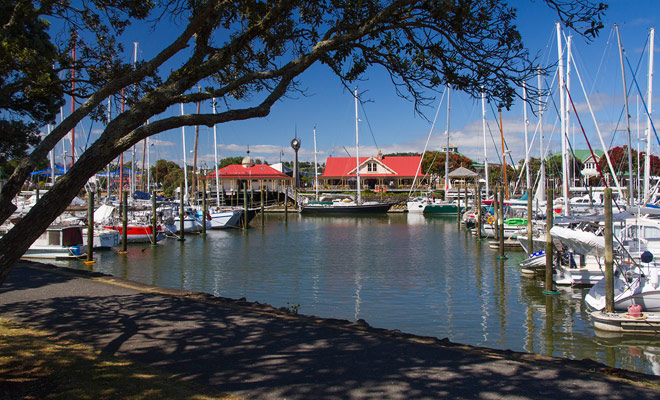
The Whangarei Marina is home to many sailing boats.
Even now the tradition continues, with hundreds of sailboats who seek refuge each year in New Zealand waters during the South Pacific cyclone season (November to April).
These great travellers enjoy the warm temperatures and ideal conditions of the austral summer to sail along the coast, exploring the many islands off the coast.
I invite you to discover all this first step in the Northland, starting with a visit of the city marina before venturing into the estuary to admire one of the most beautiful waterfalls of the country. You can also go diving and explore caves filled with glowworms.
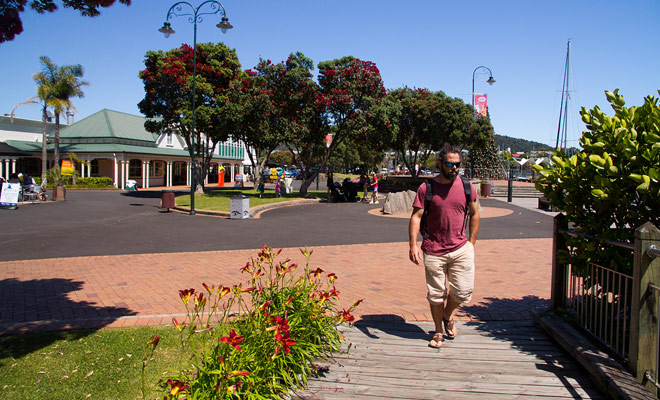
Discover a little-known region of New Zealand.
And if you stay with us until the end of this guide, we will give you a nice surprise with a meeting with the mascot of New Zealand ... But I've already said too much! Follow us and you'll see by yourself!
One day is not enough to make the tour of the area. One must choose between several activities, or stay at least two days to fully enjoy Whangarei.
City Tour and Volcano Climbing.
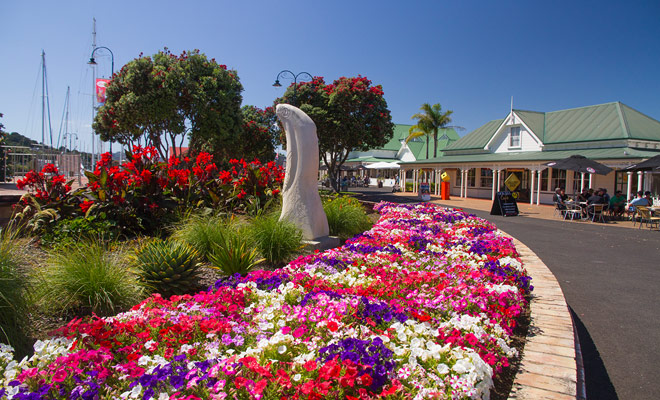
The marina of Town Basin is a very friendly meeting place.
The Marina Town Basin is the perfect place for a stroll. Thought for pedestrians, the most attractive part of the city offers paved walks lined with facilities for kids (playground) as for adults (public barbecues). It is also with The Hub, the information center for visitors with coachlines departures to the North and South.
Local shops and supermarkets are within walking distance and the market is held every Saturday on Water Street. Many car parks are available, including a dedicated one for motorhomes, and there are also a few locations where autonomous vehicles (self-contained), are allowed (close to Town Basin), which allows to spend several nights near the city center at low cost.
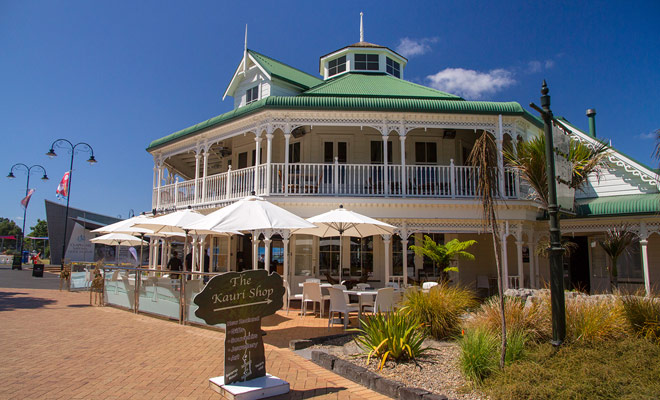
The colonial-style buildings are absolutely gorgeous.
When you're done admiring the yachts, I invite you to gain the banks of the Hatea River for lunch at the terrace of a restaurant of Town Basin, surrounded by colonial buildings.
The Mokaba Cafe will do, but the area is full of small restaurants that serve seafood and New Zealand's specialties, so you'll have plenty of choice.
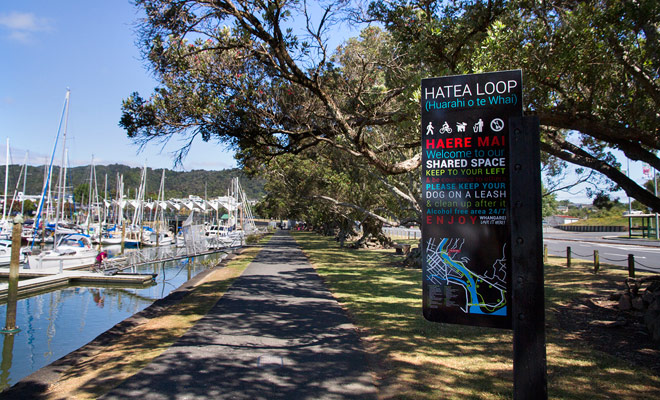
Hatea Loop is a very pleasant loop walk.
A small digestive stroll called Hatea Loop follows a path along the pleasure boats and mangroves. You will have the opportunity to buy souvenirs in small local shops. Going shopping in Whangarei is also recommended in the pedestrian walkway of Cameron Street or on Bank Street (the trendy street with its craft stores leading to the city center).
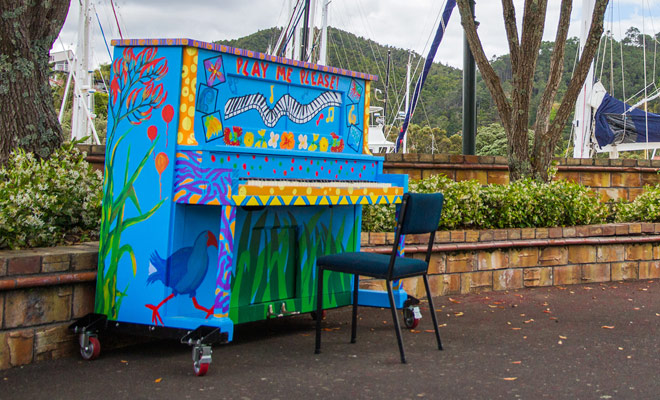
Atmosphere of the shopping district makes you want to stroll.
I do not know if it's the sweet torpor caused by the spectacle of the boats swinging slowly in the swell, or the gentle warmth loaded with sea breezes that caress the faces, but if you want to explore the region, it would be better to move right now, or you'll spend all afternoon sipping drinks at a terrace (still a valid option if you want my opinion).
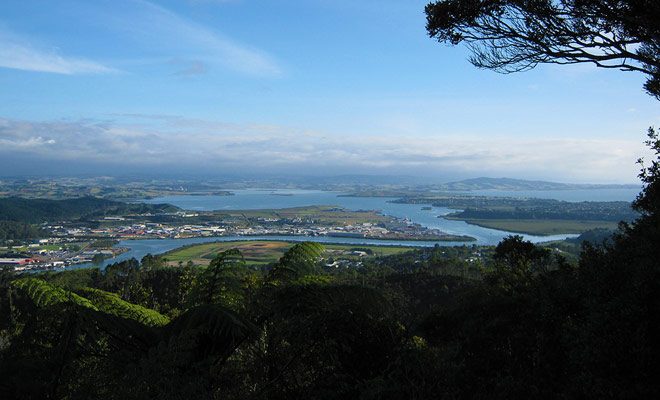
The summit of Mount Parihaka offers an unobstructed view of the area.
Let's go to Mount Parihaka. This extinct volcano (thankfully) topped with a monument commemorating World War II watches over the city of Whangarei. The summit provides an unobstructed view of the harbor and the surrounding area. You can get there by car (nobody will make fun of you, because our program is quite busy) but also on foot as from the city center, along nature trails, in the heart of the flora that lines the Hatea River.
Many beautiful forest walks allow to explore the surroundings of Whangarei.
Away from the city center you can admire the sculptures and the historic ruins of the Quarry Gardens. The park gathers 24 hectares of subtropical gardens created and maintained entirely by volunteers. It deserves a quick visit and even a brief stop at the small cafe near the small waterfall.
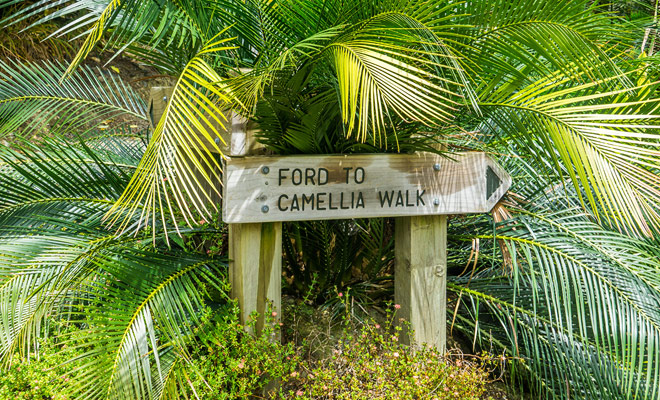
The park of Quarry Garden and its tropical gardens cover 24 hectares.
For now, you have several options depending on the length of your stay. You can visit the estuary and beaches, devote yourselves to hiking or scuba diving. All these activities cannot be botched in a single afternoon. That is why I'm going to review them all for you, and you'll only need to make a choice!
If the window-shopping in the city center leaves you indifferent, or if the weather gives you no choice, you may consider a short visit to the Claphams National Clock Museum where you can admire the largest collection of clocks in the southern hemisphere. This is hardly the best museum in New Zealand, but an original one.
The Famous Whangarei Falls.
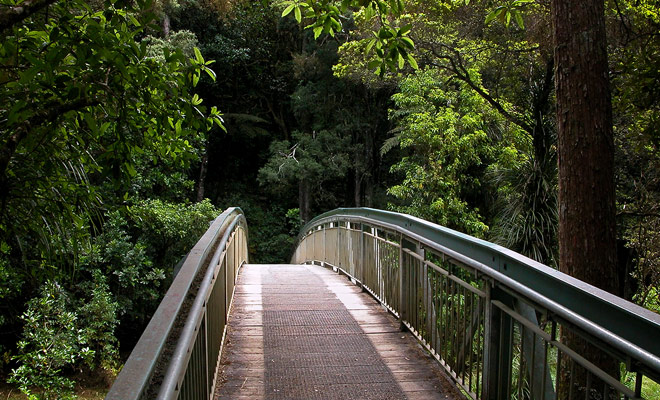
The short hike to the Whangarei Falls is magical.
The splendid Whangarei Falls are just ten minutes’ drive from the city center. Hikes of one to four hours also allow to come on foot directly from Whangerei (starting at Town Basin) or from the Mount Parihaka (which allows to chain two walks for the bravest).
You will have the opportunity to admire one of the iconic falls in New Zealand (26 m high) from three points of view, including a platform.
The ideal is to get there as early as possible in the morning when other visitors are absent and the wild forest resounds with bird songs.
This is without a doubt one of the true wonders of the Northland, one of the most famous falls of the country, but surprisingly less known by the foreign tourists who are lured by Taupo's famous Huka Falls.
But if the Whangarei Falls are far less powerful than the Huka Falls, the place is, however, infinitely more beautiful.
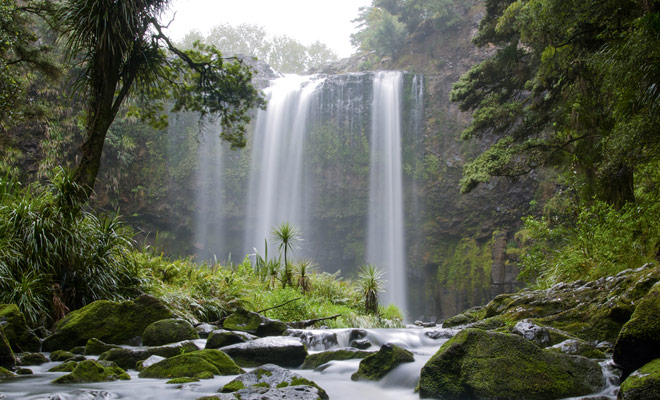
The Whangarei Falls are among the most beautiful in the country.
I must tell you that if bathing is practiced by some people, it is strictly prohibited because of the presence of the bacteria Escherichia coli which is responsible for meningitis (in the worst case) but may as well give a nasty gastroenteritis that can ruin your holidays. But don't be too disappointed, because the water is far too cold in my opinion (we are in a forest, remember).
The Kauris are trees that were already there, thousands of years before the arrival of man in New Zealand.
If you still have some empty space on your camera's memory card, you can consider pursuing the trek to the Pukenui Fallsor to the A.H Reed Kauri where you can admire Kauris, these venerable old trees being able to live more than 2000 years (in fact some of these trees were already growing before the birth of Jesus Christ).
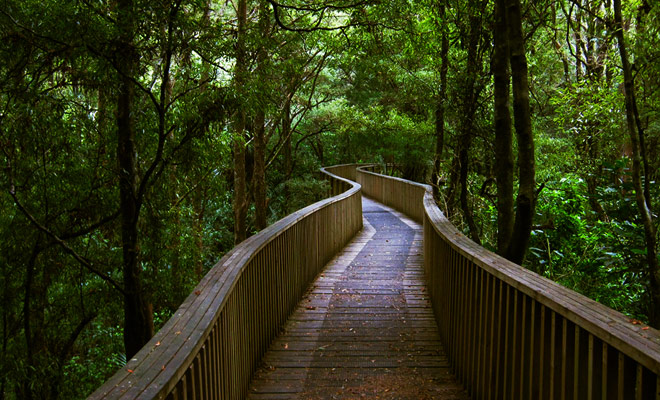
Follow the trail that leads to the thousand-year-old Kauri trees ...
If after this peaceful discovery, you need an adrenaline shot, the Adventure Forest Park allows to jump from branch to branch in a magical setting. With challenges for all levels, ziplines, suspended bridges and more, the fun and adventure are guaranteed, in complete safety and for the whole family! One could easily spend the afternoon here before exploring the coast.
The Charms of the Whangarei Estuary.
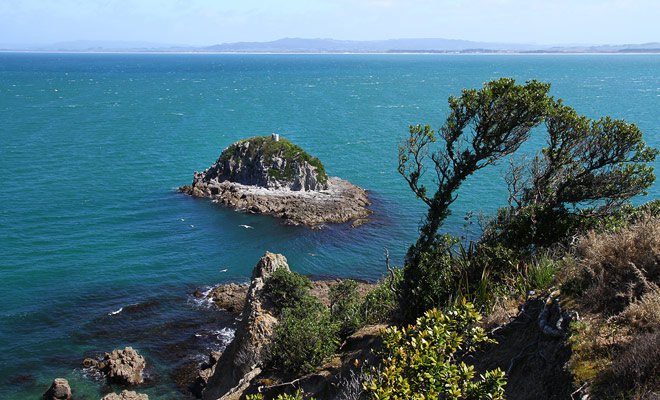
The Whangarei Heads Road is a pure enchantment.
We are back on the road following the Whangarei Heads Road, a gorgeous coastal speed highway along the estuary of the Whangarei Harbour and its islands with original or funny names like Limestone Island, Rat Island or Rabbit island, to name few.
The road is lined with coves of turquoise waters, and you will not know where to look as the entire coastline is breathtaking! As you approach Bream Head (the cutting edge of the estuary) you will discover a large nature reserve with different hikes offering spectacular views.
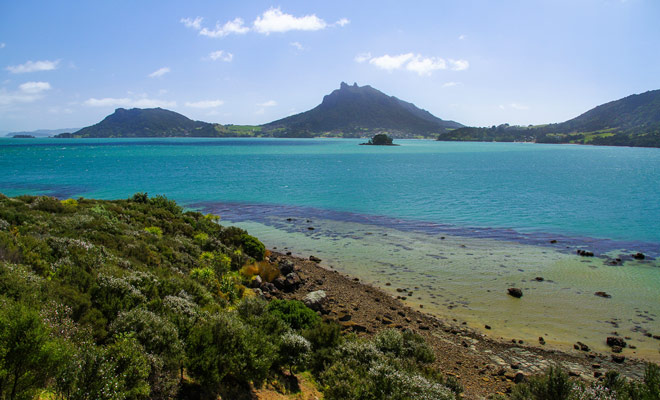
You can take out your camera ...
Thus, the Smugglers Bay Loop Track starts at Urquharts Bay, on a path through a hilly property and dotted with black cows, before penetrating in a subtropical vegetation while remaining close to the ocean.
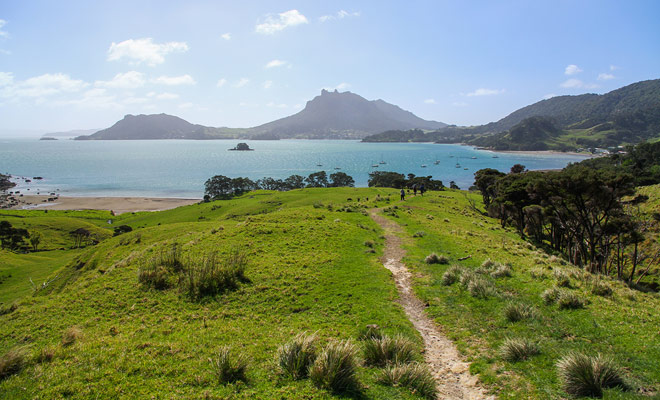
The hike to Smugglers Bay Loop Track takes about 45 minutes.
If after this hike in nature, you want to learn more about the birds of New Zealand, and you are still in the area, I advise you to go on the following day to the Whangarei Native Bird Recovery Center which takes care of injured birds before releasing them in the wild again.
The Kiwi is the mascot of New Zealand.
You'll meet Sparky and Snoopy (one-legged kiwis), Woof Woof a tui who talks like a parrot, or watch the ingenious techniques of fitness for owls, penguins and albatrosses rescued by the center. Admission is free but a small donation would help the center to continue its mission!
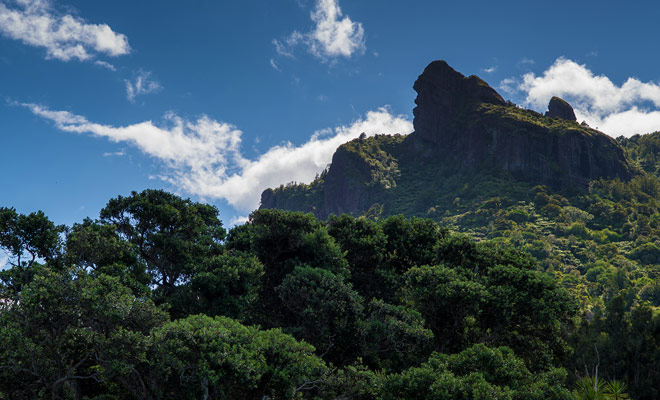
Mount Manaia is associated with a Maori legend.
If you're lucky, you can even watch kiwis whose number increases again each year thanks to the work of associations such as Backyard Kiwi, which helps these endemic birds to grow up in safety, before being released into the wild.
Retracing our steps, if your legs are not too tired, we will climb the many stairs of Mount Manaia for a panoramic view that will reward all your efforts.
This place is ideal to watch the sunset over the estuary and Marsden Point. For the bravest, you can also follow the 7.5 km of the Te Whara Track connecting Urquharts Bay to Ocean Beach where landscapes are gorgeous.
Swimming in the Mermaid Pools.
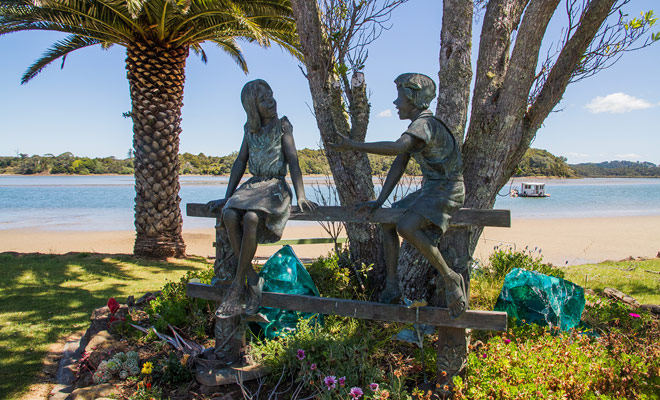
Surprises await you on the Tutukaka Coast Drive.
The Tutukaka Coast Drive is a loop that connects Whangarei to the small village of Tutukaka. The road winds gently through the countryside before skirting the Ngunguru Estuary bordered by mangroves, ideal for a kayak tour or a fishing trip.
The road then continues towards Tutukaka, gateway to the Poor Knight Islands (the best diving spot in New Zealand), before crossing Matapouri and its crescent beach. The last stop on the coast is located in Sandy Bay, a long white sandy beach where the waves are waiting for you, to the delight of surfers.
The crescent-shaped beach of Matapouri is one of the finest in New Zealand.
It is also possible (as everywhere in New Zealand) to take surf lessons. Different schools in the country pretend to make a surfer of you in less than three hours... Of course, in such a short interval you will just learn to stand up on a board for a few seconds! But one must start one day, and surf definitely worth the try!
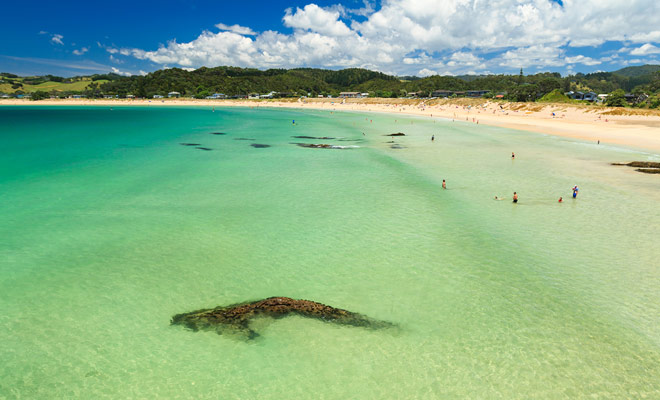
The beach of Matapouri Bay is one of the most beautiful in New Zealand.
On the other hand, if you are basically looking for farniente in the sun, I suggest you enjoy the peaceful beach of Matapouri Bay to swim in crystal-clear waters, especially at the north of the bay where the rocky scenery is a extraordinary.
By continuing the walk up to the end of the beach you reach the beginning of an excursion that climb a hill after a small trail in a forest.
The summit will reward you with a spectacular view of Matapouri Bay especially on the rocky coast exposed to the ocean while you descend on the other side of the hill.
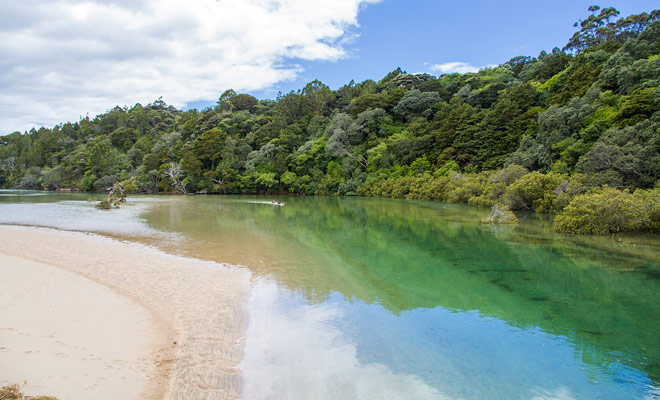
There are many paradisiacal beaches in the area.
If you want to go on, the descent is fairly risky and you must proceed with great caution (good shoes required). A surprise awaits you, because this secret path leads to the Mermaid Pools, turquoise natural pools of unreal beauty and known only by the locals.
The Mermaid Pools are turquoise natural pools, filled with seawater.
Please note that some guides still claim that the Mermaid Pools can be reached through a tunnel in the rock, but this route was condemned following a landslide. The path through the hill is now the only way to reach the natural pools, which certainly complicates access, but fortunately limits the number of visitors on location.
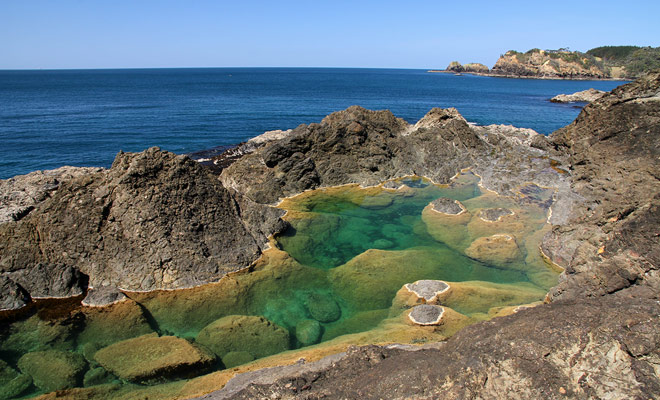
Come and swim in the splendid Mermaid pools!
Filled with sea water at high tide, the mermaid pools is warming up in the sun and the temperature is perfect for swimming. Find a place to store your stuff in your backpack, put your swimsuit and jump in the water of this natural wonder.
Please note, however, that the access to the Mermaid Pools is only possible at low tide, and one should check in advance the tide schedule before coming.
Dive Poor Knight Islands.
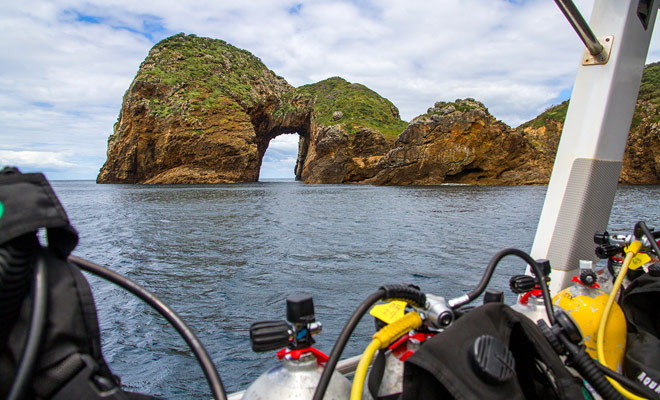
The best diving spot in New Zealand!
The archipelago of the Poor Knights is a real gem for divers of all levels. Protected by the government in collaboration with local Maori tribes, these sacred lands are not open to the public for several decades excepted for diving..
A significant number of endemic species are living on the islands to safe from predators. The marine biodiversity is incredibly rich and nudibranchs, carpet sharks, scorpion fish, rays, dolphins (and even orcas if you are lucky) are on our diving session program.
The Poor Knight Islands were on the list of the ten favorite diving sites of the Commandant Cousteau.
In addition to this particular fauna, one can also encounter tropical fish coming from the warm ocean currents of the East Auckland Current, and an intriguing flora covering every rock millimeter.
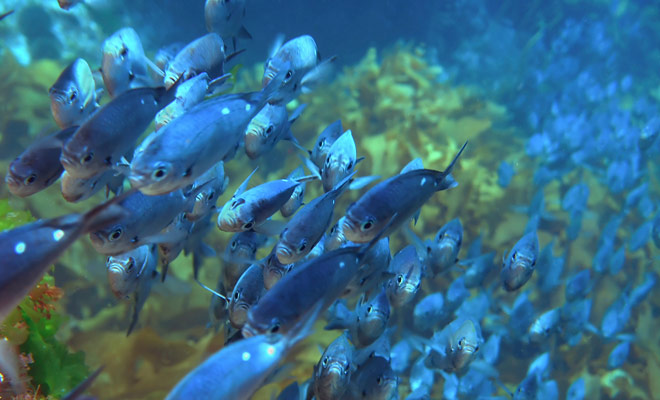
Make your first dive in New Zealand.
The warmth of the tropical water is missing for sure, but this only adds more charm to these islands which possess other advantages like countless arches and underwater caves to explore.
Diving with almost 12 mm of combination and the ballast that goes with it won't prevent you from going into the water for an unforgettable session!
Experts from the local company Dive! Tutukaka will guide you in this marine reserve, to dive, swim or simply enjoy the coastal scenery.
Very competent, the crew takes advantage of the crossing to tell the story of the Poor Knights Islands, explain the Maori traditions and the origin of biodiversity that exists on these fabulous islands.
Beginners are welcome, and if you're interested you can find a Kiwipal guide fully dedicated to diving in New Zealand.
Under the Starry Sky of Waipu Caves.

The Waipu Caves are about twenty kilometers from Whangarei.
Let us leave the ocean a few moments to discover another natural treasure located this time under the earth in the caves of Waipu. The attraction is located away from Whangarei but worth a little detour, especially if you had not planned to visitWaitomo Caves during your trip to New Zealand. Best of all, this activity is completely free.
The town of Waipu is 40 km south of Whangarei but the caves are actually halfway between the two cities, accessible to any vehicle by a gravel road.
Some discreet sign posts will keep you on track, and you will soon arrive in a large valley surrounded by cliffs and forest.
Before starting the tour, you have to prepare yourself for this trip without a guide.
Plan a flashlight per visitor (headlights would be a plus, but are not essential), waterproof shoes or sandals (in summer), a fleece during winter because it's cold underground, and possibly a raincoat.
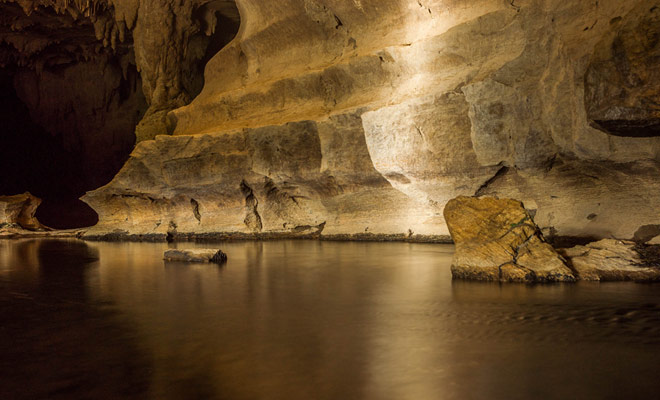
According to the weather, the cave will be more or less flooded.
The Waipu Caves are a series of large cavities traversed by a stream. It takes just few bends to find yourself in total darkness. The trail that goes into the cave is made of clay and the weather of the day before influences the quality of the descent during this improvised visit.
Journey into the center of the earth to admire the glowworms.
Some slipping are to be feared and one must not be afraid to get dirty or to walk in cold water! However, this is not the kind of cave where you might get lost or stuck. But the basic safety rules apply here, and you should always announce your daily schedule to a third party (with the help of the Outdoor Intention website for example).
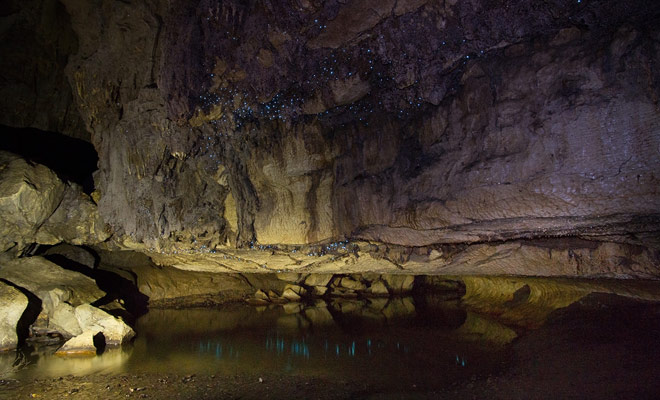
The glow-worms illuminate the vault of the cave.
After only a hundred meters indoor, just turn off the flashlights to contemplate countless small bright dots that cover the ceiling of the cave: the glowworms.
These endemic glowworms from New Zealand produce a bioluminescent glow in order to burn their waste and attract victims to devour.
When approaching closer to the walls, you can see sticky filaments created by the larva to trap their preys.
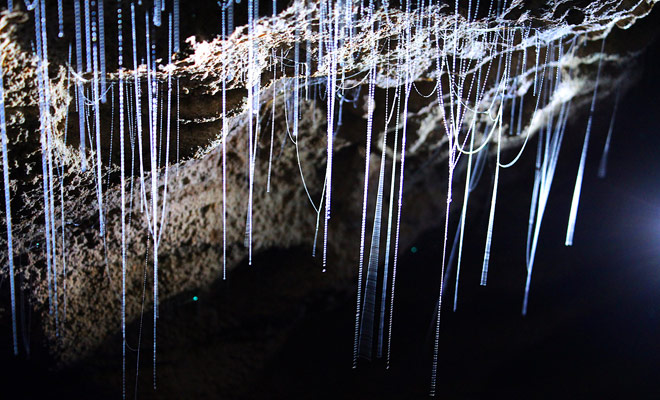
In reality, the glowworm shines to attract prey!
However, do not steer your torchlight on these fragile creatures living in the dark because they do not tolerate bright light. Similarly, to preserve the cave, do not touch the stalactites which are very fragile.
The cave then plunges during several hundred meters. The more adventurous can explore other cavities (but the first room is already one of the most impressive).
The exploration in the dark with light torches and the echo of the voices is quite daunting, and you will be relieved to retrieve daylight (with a great memory).
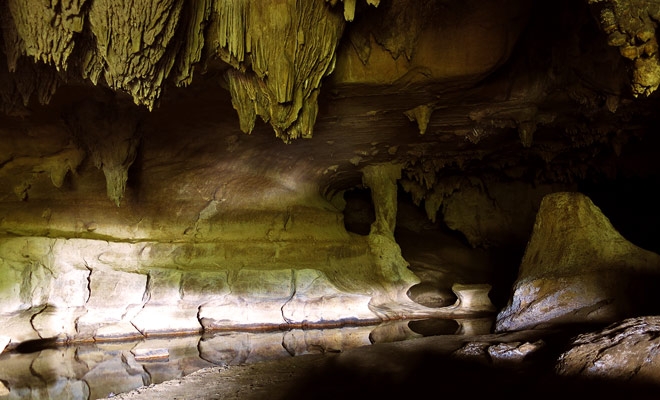
The Abbey Caves are close to Whangarei.
Unlike Waitomo Caves which are also located on the North Island, the Waipu Caves are certainly less spectacular but the underground exploration is more intense when one is not surrounded by dozens of other visitors.
The Abbey Caves which are located near Whangarei are more accessible and contain glowworms as well. Attendance of this location is far more important, and if you're not pressed for time, we recommend instead the deserted Waipu caves.
Attending a Kiwi Release.
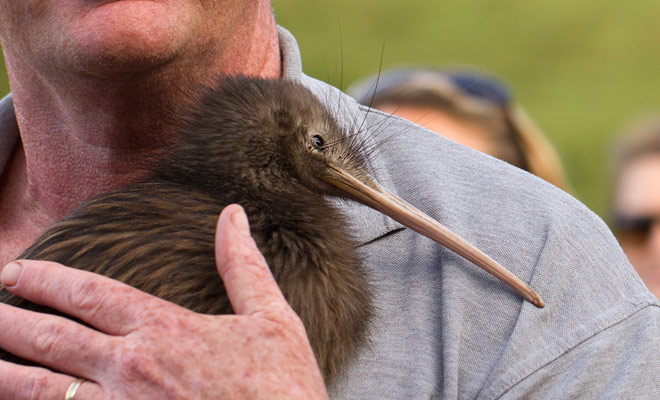
The Kiwi is the official mascot of New Zealand.
I saved the best for the end, and if you took the time to fully read this article you've earned the right to meet the famous kiwi living in the Northland, and especially in the Whangarei's forests.
The Kiwi, this adorable little bird with a long beak (but wingless) is the mascot of New Zealand, although paradoxically, most people have never seen a real specimen in the nature. Because the species is mostly nocturnal, it is difficult to observe Kiwis without visiting a wildlife park such as Rainbow Springs in Rotorua.

You can attend the release of a kiwi in the wild.
Because the star is scarce even in the Northland! The species is now critically endangered, and owes its survival thanks to the hard work of voluntary associations like Kiwis for Kiwi or Backyard Kiwis.
Fortunately, decades of hard work are beginning to bear results, but it is still too early to claim victory, and whether the decline seems contained, the survival of the species is not yet assured in the long term.

After growing up safe from predators, the kiwi will regain freedom.
If the collision with cars is still the main cause of mortality for the kiwis, the dog bite is also a major one. Our four-legged friend can unwittingly crush the fragile chest of the bird while trying to play with him.
Facing these multiple threats, the Kiwi has to grow up free from predators to be able to survive. Initiated by locals from Whangarei, the reintroduction program is a real success based on education of the population.

You will discover the kiwi and understand how to protect it.
This is why the release of Kiwis is a major event. Once they are strong enough to survive in wild nature, birds aged of one or two years old are set free into natural parks within the Whangarei area.
The release of Kiwis results in public meetings organized by associations. Volunteers take the opportunity to expose simple preventative solutions to increase the survival rate of kiwis.
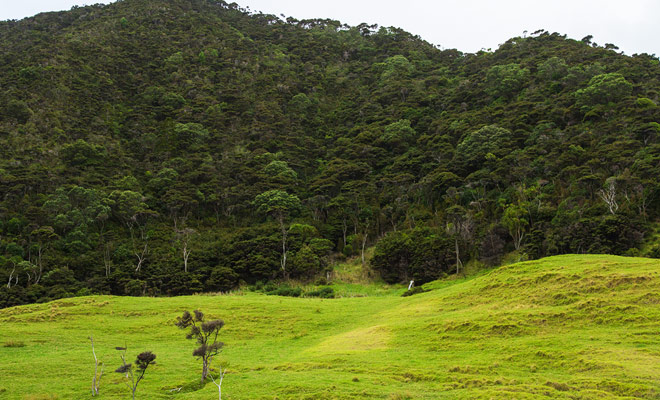
Somewhere in the forest, the kiwi is already working to make its nest.
You can perfectly attend such an event! Just keep yourself informed and if the dates of your stay in New Zealand coincide with a release, do not miss your chance!
A Kiwi who made the journey in a wooden box is presented to his fans. After this brief instant of glory, the animal (equipped with a transmitter) leaves the crowd to gain his new home in the forest. The small measuring device is used to control the success of the reintroduction, and you can even spot the position of our little hero on a map online!
To be informed of the next releases of kiwi in Northland, please have a look on the website of the Backyard Kiwi association.
Whangarei, Jewel of the North Island.
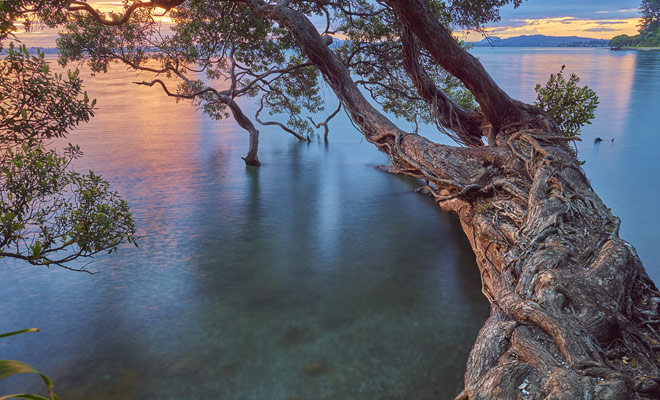
Whangarei is largely underestimated and worth a visit.
When one considers the beauty of the location and the beautiful walks, it seems inconceivable that Whangarei can be overlooked by most of foreign tourists. Yet, Whangarei has all the typical characteristics of subtropical New Zealand, and some real gems that deserve to be in Kiwipal's best of.
In fact, travel agents and the tourism industry have part of the responsibility. Aside from diving, the area offers fewer paying activities than in the Bay of Islands which is just one hour’s drive away. For a travel agent, it is easier to earn commissions with dolphins swimming tours, instead of suggesting Whangarei's free activities.

Ideally two days to explore the area.
Whangarei is like a pearl close to a diamond (the Bay of Islands). It's easy to forget its value which is nevertheless immense. Unlike visitors from around the world, the Kiwis are not mistaken, and the city and its surroundings attract vacationers from all New Zealand.

An unmissable stopover between Auckland and Bay of Islands.
One must not forget that this article is just flying over the activities of the region. You could perfectly imitate the Kiwis and spend your entire holidays in Whangarei. However, the most important visits can be planned on one or two days, which is perfect for a road trip.
Whangarei is a halfway stopover between Bay of Island and the Coromandel Peninsula. If you want to taste the authentic beauty of Northland, you will not be disappointed. And if you need advice to organize your stay, may I introduce Ben the Kiwi who will answer all your questions in his dedicated section below. Have a nice trip in New Zealand !


Questions & Answers.

What can I do for you? I am at your disposal if you have any questions to organize your visit to Whangarei and its region, so do not be shy, I am here to help you.
- All topics ... 18 answers in total
- Waipu Caves 7 answers
- Whangarei 4 answers
- Diving 4 answers
- Mermaid Pools 3 answers
Waipu Caves
- Is the visit to the caves dirty?
It all depends on the weather. In dry weather, and if one does not slip, it is possible to visit without getting dirty. If the floor is wet and slippery, you could almost come in a swimsuit in the summer.
- Should I bring a torch light?
Yes, and it is preferable that each visitor is equipped with his own electric flashlight.
- Can we visit the caves without a guide?
Yes, just move carefully and be equipped with electric torches.
- Is the visit to the Waipu Caves dangerous?
No, as long as you take your time, and own a flashlight with new batteries. Without light, you would be plunged into obscurity.
- Can the glow-worms be photographed?
No, alas, because the rendering is very mediocre, we need high-end equipment and professional know-how (like our reporters). Moreover, the multiplication of the photos is deprecated (especially with a flash) because it hurts the shiny worms.
- Should we also visit the Abbey Caves?
It would be somewhat redundant, even if the visit itself is interesting.
- Are there any spiders in the caves?
No, the latter are relatively few in New Zealand, and if there is a venomous species (katipo) it is almost extinct and does not live in the region and even less in the caves.
Whangarei
- What is the best restaurant in town ?
The Top Sails restaurant, away from the city center, but with great views, serves outstanding modern cuisine. But you will also find excellent establishments located in downtown Whangarei.
- How long does it take to visit the city?
For a simple visit to the marina and its surroundings, half a day would be nice already.
- Is a short visit enough?
To enjoy Whangarei and its surroundings, it takes at least a full day, if not two, if you wish to dive or explore the Waipu Caves. That said, in good weather, a simple stop at Town Basin for lunch would already be nice.
- Can we swim at the Whangarei falls?
No, swimming is forbidden, and diving dangerous because of the rocks. You will see people bathing, but do not follow their bad example, because the bacteria Escherichia coli infects the water of the river.
Diving
- Can beginners dive?
Yes, the diving baptism is a specialty of the Dive Tutukaka company. You will be perfectly supervised by experienced instructors.
- Can we dive all year round?
You can dive all year, but in practice it is better to avoid the months of October to December because the plankton reduces the visibility to less than 15 m whereas you can expect a visibility of 30 m the rest of the year, year.
- Can we dive without a guide?
If you have adequate experience to hire your equipment, you can dive without a guide, but you will have to pay for the boat trip to the Poor Knight Islands.
- What is the best diving company?
Dive! Tutukaka is the company that has the monopoly on the dive site of the Poor Knight Islands. It is by far the best diving company in New Zealand, as evidenced by the many awards of excellence in recent years.
Mermaid Pools
- Can you swim all year round?
The month of February is the most suitable for swimming, and if it is possible to bathe between December and March, the rest of the year it will be too cold to really enjoy it. That said, you can perfectly take surf lessons in combination.
- Is access difficult?
The access by the hill that is not the easiest requires a minimum of caution and good shoes not to slip.
- Can we change our clothes on site?
You will not find any hidden location to put your swimsuit. You will have to come with your swimsuit on you, or change discreetly under a beach towel.



